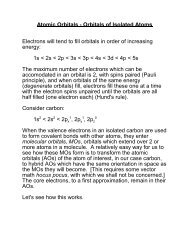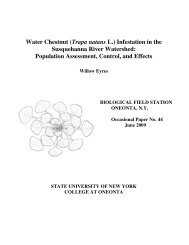Chapter 7 Electron Configurations and the Properties of Atoms 7.1 ...
Chapter 7 Electron Configurations and the Properties of Atoms 7.1 ...
Chapter 7 Electron Configurations and the Properties of Atoms 7.1 ...
You also want an ePaper? Increase the reach of your titles
YUMPU automatically turns print PDFs into web optimized ePapers that Google loves.
<strong>Chapter</strong> 7 <strong>Electron</strong>ic <strong>Configurations</strong> <strong>and</strong> <strong>the</strong> <strong>Properties</strong> <strong>of</strong> <strong>Atoms</strong><br />
Like sodium, magnesium is expected to easily lose its valence electrons, but not an electron from a<br />
lower-energy shell. As shown in Table 7.5.1, <strong>the</strong> first <strong>and</strong> second ionization energies for Mg are<br />
relatively low, but <strong>the</strong> third ionization energy (IE3) is more than 10 times greater than IE1.<br />
Table 7.5.1 First, Second, <strong>and</strong> Third IE values for Mg<br />
Mg(g) Mg + (g) + e IE1 = 738 kJ/mol<br />
Mg 2 (g) Mg 2+ (g) + e IE2 = 1451 kJ/mol<br />
Mg 2+ (g) Mg 3+ (g) + e IE3 = 7733 kJ/mol<br />
In general, when metals form cations, <strong>the</strong>y lose electrons from <strong>the</strong> highest-energy occupied orbitals,<br />
those with <strong>the</strong> highest n value. Transition metals have valence electrons in ns, (n 1)d, <strong>and</strong> in <strong>the</strong><br />
case <strong>of</strong> lanthanides <strong>and</strong> actinides, (n 2)f orbitals. When a transition metal forms a cation, electrons<br />
are first lost from <strong>the</strong> outermost occupied orbital (<strong>the</strong> orbital with highest n). For example, when iron<br />
forms a +2 cation, it loses two 4s electrons.<br />
Recall that <strong>the</strong> 4s orbital is filled before <strong>the</strong> 3d orbitals are filled. However, electrons are removed<br />
from <strong>the</strong> highest-energy orbitals because those electrons feel <strong>the</strong> weakest attractive “pull” from <strong>the</strong><br />
positively charged nucleus.<br />
Transition metals <strong>of</strong>ten form more than one cation. Iron is commonly found in both <strong>the</strong> 2+ <strong>and</strong> 3+<br />
oxidation states. In <strong>the</strong> formation <strong>of</strong> Fe 3+ , two 4s electrons <strong>and</strong> one 3d electron are lost.<br />
- 22 -
















